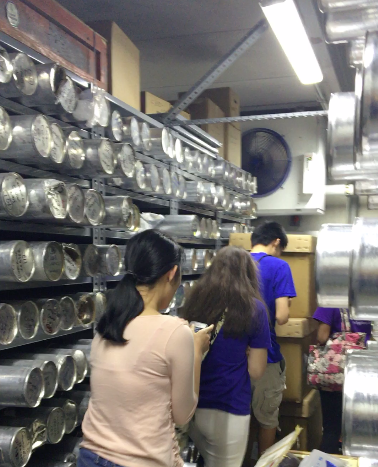Until I spent three weeks with Summer Institute (SI) and Young Women’s Summer Institute (YWSI) students this past summer, I had never once felt any excitement whatsoever about science. Looking back on that experience as the fall semester quickly approaches, the students’ passion for science was contagious and has stuck with me. As OH-TECH’s communications intern, I followed the students on field trips and documented their experiences on social media. Here are some of the highlights.
Site: Byrd Polar Research and Climate Center

Lesson Learned: The increasing importance of Arctic research in order to preserve it and combat climate change.
My view: I didn’t know the true meaning of “cold” before this field trip. Having worked at an ice cream shop in high school, I thought going into a freezer filled with Arctic ice cores would be no problem. I couldn’t have been more wrong – at about negative 30 degrees Fahrenheit, this was colder than any of us could’ve anticipated. It gave me a much deeper appreciation for the work researchers have done in the Arctic. The air was so cold it felt almost suffocating as we walked through the freezer without coats or gloves. Ohio winters pale in comparison. This field trip gave students a way of literally feeling what Arctic researchers feel when out in the field.

Site: Battelle Darby Creek Metro Park
Lesson Learned: A fish can be lightly electrocuted and ultimately will be fine.
My view: These girls are fearless! This field trip was the polar (pun intended) opposite of the Byrd Polar Research Center. We spent the afternoon outside in the sun learning about electrofishing– a process in which an electric charge sent into the water causes fish to briefly faint and float to the surface – to sample fish populations, chemically testing the water quality of the creek (it’s “excellent”!) and catching macro organisms in the water. It was so much fun seeing the girls boldly pick up crayfish and dump creek water out of their rain boots. The kids were not hesitant to get muddy!
Site: State of Ohio Computer Center (SOCC)

Lesson Learned: Without these computers, humans wouldn’t be nearly as capable of carrying out advanced research.
My view: The noise of the computers’ fans was incredibly loud. You know how using your laptop for a while makes it get hot underneath? Imagine that heat multiplied by 100. What struck me about this field trip was the size and volume of the machines. The room is built to accommodate them, with dozens of sprinklers on the ceilings in case the machines dangerously overheat and special vents in the floor to prevent overheating from happening. The plastic “curtains” are in place around the backs of the cabinets to keep the heat contained, while the room itself is kept cool. The whirring from the computers’ fans was so loud that everyone had to shout to be heard, even when standing right next to each other. The size, heat, sound and power of these supercomputers as compared to a laptop were incredible. As newcomers to the SOCC, even though we knew these massive machines are behind some of the most advanced, complex research out there, the students and I were in awe.

Site: Ohio State University Center for Automotive Research (OSU CAR)
Lesson Learned: Increased energy efficiency is the future of transportation.
My view: It’s amazing that a 20-something student can create something so significant. I’m a student at Ohio State, but I saw a different side to the university when I visited the CAR. CAR is where Ohio State engineering students research fuel economy, safety and sustained mobility. We saw the cars and motorcycles the OSU students have worked on and raced in competitions, and we learned more about the students’ work. The vehicles have been engineered in ways that make them more environmentally friendly and help them run more efficiently.
Site: Scarlet Laser Facility

Lesson Learned: This laser is 400 terawatts, which is 400,000,000,000 kilowatts. (Most households use 30 kilowatts per day.)
My view: Before we could enter the facility, we were given a scrubs-like outfit that included shoe covers, a white lab coat and a hair net. Because the laser is so powerful, we were unable to see it in action. The laser’s quick burst of x-rays captures images of biological molecules without destroying them. It can be used, for example, to research cancer therapy and alternative energy sources.
The field trips during SI and YWSI made me feel as though I was part of something greater than myself. From learning about the importance of climate research and fighting climate change to seeing the supercomputers that help us complete the most advanced research, I was exposed to things I had never been exposed to before. And the same can be said for the students. The field trips are part of what makes the OSC summer programs so influential, and observing the interaction between the students and the staff was quite interesting. These students were able to see real-world examples of fields they may enter and help to mold in the years to come. So while it was an experience I won’t soon forget, I’m also looking forward to seeing what the future holds for many of these gifted students.


